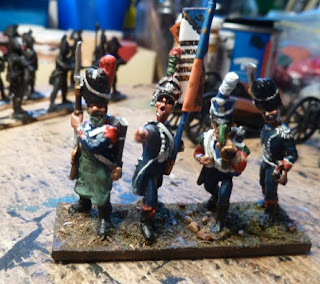 |
| Our Legere command stand - the figures are Old Glory & Hinchcliffe (the hornist). |
 |
| Should have done a 'before & after' as I've already applied the green stuff to the carabinier |
 |
| Detail showing the scratch-built axe |
Dunno if I got the sling arrangement for the axe correct - I think the entire axe head was encased in a canvas sleeve - but I have seen them slung like this too. Anyway Smiling Jim here now looks more suitably ferocious with his bushy beard as befits a pioneer type and most importantly, he's got an axe!
Once I got this one out of the way I got stuck into my caisson model. What a challenge! It was missing its fifth wheel (that I belatedly discovered is attached on the rack at the rear) and a funny little cage basket arrangement at the other end which has horse blankets stuffed in it or something. Anyway I reattached the rack and bent it into the shape required and found a suitably sized wheel to go on it. The spare wheel has a boss and plate arrangement to hold it to the caisson rack which I ended up making out of plastic bits and pieces. The other end of the rack was bent into shape to fit the front as the carriage basket. In addition, given that the figure supplied with it is opening the cover to it I thought the caisson should have some ammunition in it, hence the 'green stuff' modelling putty.
I should emphasize that I was guessing what the inside of a full caisson would look like, based on what I know of what the Austrian artillery used. One picture I saw showed a partitioned caisson with three or four sections containing powder and shot in stitched into bags. I opted for something a little more ad hoc with stacked ammo under a canvas cover, with some loose shot and some powder bags at the other end. The artilleryman figure supplied with it is an interesting pose - it could be an Austrian surrendering too! (Hmmm, one of the Austrian casualty poses was a figure running away, now one in a 'hands up' pose - am I sensing a theme here?)
 |
| Hey I'm just lifting the lid on the caisson - not surrendering OK?! |
While artillery ammunition was 'bagged up' the powder in an exact amount in a linen bag, placed into a larger one with the ball on top and then stitched up, it was equally likely to be stored separately when on the march. When rammed down the gun barrel, the powder bag would be directly under the touch hole. The detonator was a quill full of fine powder used to prick a hole into the bag which was then ignited via the touch hole. A hazardous business made less so if you had everything sealed up rather than a lot of loose powder but you can imagine going through this prepared shot very quickly in action.
To give you an idea, the average caisson carried 300 prepared shot, ideally a caisson for each gun in a battery. The gun limber had a small shot locker which carried up to 30 prepared bags of powder and ball (for a 6 pdr - obviously less for a larger calibre gun) but operating at peak efficiency - and Austrian artillery was nothing if not efficient! - this would be expended in between 15 - 30 minutes of continuous firing. One caisson would give a battery of four to six guns about an hours worth of continuous firing. At Aspern-Essling nearly 200 Austrian guns were estimated to have fired off more than 20,000 rounds, firing over nearly 10 hours. For Wagram it was nearly double that amount - so that's a lot of artillery caissons! Massed artillery in any battle was an enormous enterprise, with hundreds of wagons drawn by thousands of horses just to keep the guns firing.
Well, that's the caisson done. The base is about 5mm shorter than the artillery limber base (minus the lead horse team section) so hopefully not taking up too much room on the table. Now on to the Wurst gun battery. And a Grenzer battalion, and another one of Hungarian line and ... about time to put the brushes down for a bit and do some wargaming I think!
Cheers,
Doc
As a postscript to this post and a shameless plug for the chance of a prize I present the title banner from Big Lee's latest post on the BLMA blog: http://www.blmablog.com/2013/07/blmas-millionth-pageview-givaway.html
Seriously folks, its quite an achievement for our hobby - I've not heard of anyone reaching that milestone so well done to the big fella and in blogging terms lang may yer lum reek!












Nice job on those conversions. I particularly like the brushwork on that caisson-it's beautiful.
ReplyDeleteThanks Anne - coming from a master of the brush such as yourself that's quite a compliment!
DeleteLovely conversion work, Doc!
ReplyDeleteOh I say Sir, some fabulous work here.
ReplyDeleteyou know I always love to see figures with horses :) When I was a kid I didn't have many toys (poor times, difficult times) but all of the ones I did have were figurines of horses :)
ReplyDeleteThe horses made by the Perry brothers are particularly beautiful and well proportioned. They sculpt some really nice poses. I like the one above thats cropping the grass in front while its rider is leaning forward and resting on the saddle pommel.
Deleteyep, they're particularly lovely when captured in a dynamic movement
DeleteGreat conversion work!
ReplyDelete